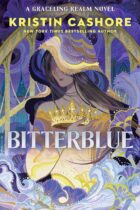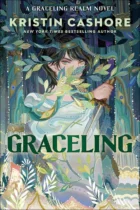Book Spotlight: Bitterblue (The Seven Kingdoms Trilogy, Book 3) by Kristin Cashore

Since this post was published, two more books—Winterkeep (2021) and Seasparrow (2022)—were released, and the 5-book series was re-released as The Graceling Realm Series.
Book Spotlight: Bitterblue (The Seven Kingdoms Trilogy, Book 3) by Kristin Cashore
WELCOME back, Beardies!
Thank you for sticking with me through a week of posts about the Seven Kingdoms Trilogy! I hope you have enjoyed the posts as much as I enjoyed reading the books—and then dissecting them from a writer’s standpoint! Today we reach the final installment of Seven Kingdoms, Bitterblue, which is the sequel to Graceling, set eight years after the conclusion of that book and forty-eight years after the end of Fire.
{—PREMISE—}
EIGHT years ago, Princess Bitterblue and her mother, Queen Ashen, escaped the evil clutches of her father, King Leck of Monsea in the Seven Kingdoms. Ashen was killed in the escape attempt, but Bitterblue survived and went on to assume the throne of Monsea at age ten. Now, though, Bitterblue is Queen of a nation with many problems. Leck was a tyrannical, sadistic ruler and had the Grace, or supernatural talent, of deception. During his thirty-five years as King, Leck’s Grace forced his subjects to accept every word he spoke as truth, rendering them completely unable to think for themselves. Bitterblue wants to set things right, but her advisers seem determined to drown her in useless tasks, refusing to answer her questions about Leck’s reign or even allow her to make amends for his wrongdoing. Frustration leads Bitterblue to devise her own way to seek the truth, and she discovers that Leck’s cruelty went far beyond her wildest dreams. Not only that, there are those in Bitterblue’s court who would rather see her killed than expose the truth about her father.
{—GEMS FOR WRITERS—}

1. MAPS...
MAPPING is an important part of world-building. It keeps the writer from geographical inconsistencies–and the need to edit for those inconsistencies! Maps also help the reader visualize the setting. Kristin Cashore‘s mapping is second to none, with double-page maps of Bitterblue’s castle and rooms, Leck’s rooms, the East City, the Seven Kingdoms as a whole, and more. I am a huge fan of maps in fantasy books, and when I purchased my copy of Bitterblue, I spent an hour in the Barnes & Noble café just ogling the maps. Ironically, on that same day, Joshua did a great post on world-building and maps. If you haven’t already, please take a minute to go check it out!
2. CHARACTERIZATION...
I have loved the characterization in these novels from the beginning, but it is especially well-done in Bitterblue. The last time the reader saw Bitterblue, she was an immature girl of ten years, on the run from her cruel father, and she acted like it. In this volume, the reader sees how her memories were distorted by her father. She feels this distortion acutely, which makes her a sympathetic heroine. In the beginning of this story, Bitterblue is in many ways still a child and very naive. By the end, however, she has grown into a remarkable young woman and a good monarch, able to see that not all cruelty is intentional and that sometimes the best way to make amends for the past is to offer hope for the future.
3. GRACES...
4. love IN MANY FORMS...
SOMETIMES I feel like writers forget that love comes in other forms than just romance. Even worse, I have read many books where a romance seems to be forced into the plot. Thankfully, Kristin Cashore avoids both of these pitfalls. Confused and afraid, Bitterblue is constantly surrounded by people who love her. She has friends to laugh with, shoulders to cry on, and people to give her advice. Bitterblue never finds lasting, romantic love, but love is not missing from the story. I also truly enjoy the portrayal of homosexual characters in this trilogy. They simply exist in these pages as a matter of course, and, for the most part, are accepted by all. I only wish the same held true in our world, and I applaud Kristin Cashore for celebrating love in so many forms.
{—RATING—}
{—CONCLUSION—}
IN The Seven Kingdoms Trilogy, Kristin Cashore has built a world that is complete and real, populated it with characters I would love to have as my real-life friends, and made me eager to visit it time and again. In Bitterblue, Cashore leaves the characters in a place where I am content to let them go, bringing the trilogy to a satisfying close—though, if she ever did write another book, I would read it gladly.
Happy Reading and Happy Scribing!

ELIZABETH J. NORTON
***Bitterblue (2012), by Kristin Cashore, is published by and copyright Dial Books for Young Readers, an imprint of Penguin Group (USA), Inc.





